Fuji's Top Model - the Fujifilm Fujica AX-5
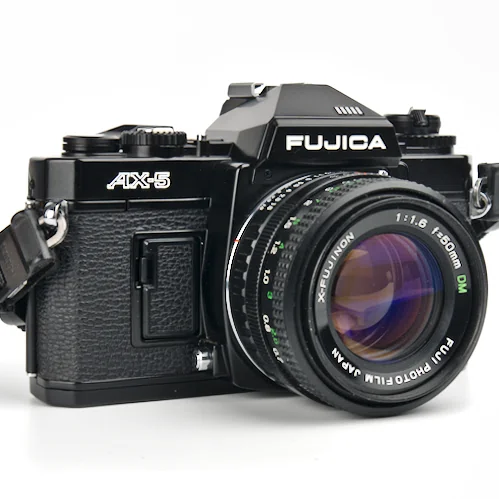
Fujica is the brand name Fujifilm used for the 35mm film SLRs the company produced. Released in the early 1980’s, the Fujica AX-5 was the most advanced model available. The two other models in the Fuji AX line were the AX-3 and AX-1.
Price & Where to Buy
The camera was not widely distributed throughout the United States. I don’t know about other locations outside of Japan.
Lenses for the camera can often be difficult to find. The introduction of autofocus in the mid 1980’s put an end to sales.
Your best option is going to be to check the current prices on eBay.
With some patience, you should be able to find a good deal on a camera and a 50mm lens. Cameras bundled with more lenses are attractive because AX lenses can be hard to find.
Camera Battery - 4LR44
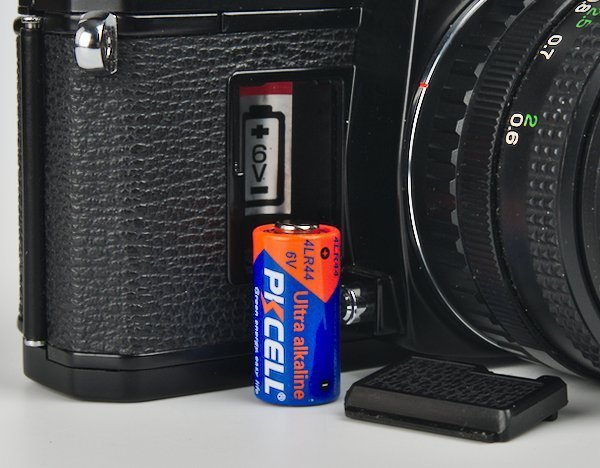
The camera has an electronically controlled shutter. It will not function without a battery installed.
There are many options available for 1.5V batteries. The easiest camera battery to use is a 4LR44.
Installing the battery can be difficult due to a tight-fitting battery compartment. Inserting the negative (-) end in first will make it easier.
4LR44 batteries can easily be found in stores. They are used in dog bark shock collars. You can save money by buying them online. Keep in mind that you will want to carry a spare with you.
Battery Voltage Check
When the battery is voltage gets too low, the shutter will not operate at the correct speed. As a result**, the camera will not capture the correct exposures.**
You can check if the battery voltage is low by turning on the camera and depressing the shutter button halfway.
If the red LED opposite the “B” on the bottom of the shutter speed scale flashes approximately 4 times a second, you need to change the battery.
If no LEDs light up, the battery is completely dead and the shutter will not fire.
On/Off & Self-Timer Lever
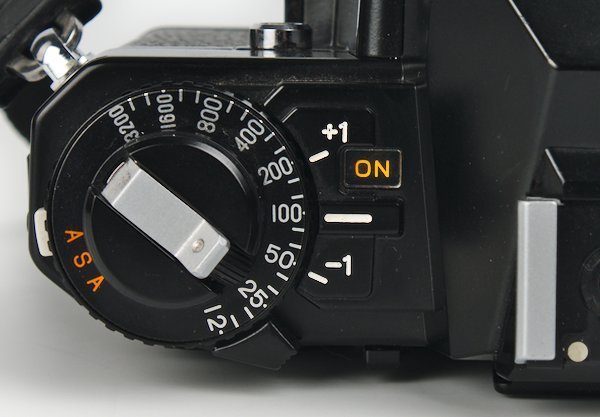
I thought the camera was broken because I could not find the on/off lever. It is embarrassing to admit, but I had to check the camera manual.
The lever is located along with the ASA dial, below the “-1”. It needs to be rotated away from the camera body to turn the camera on.
Shutter Speeds
Shutter speeds on the Fujica AX-5 range from 2 seconds to 1/1000 of a second. There is a bulb mode. Flash sync is 1/60 of a second.
There is an X-sync port located above the lens lock release lever. A center fire pin hot shoe is above the viewfinder. Thanks to the centerfire pin, almost any flash will work with the camera.
Automatic Exposure Modes
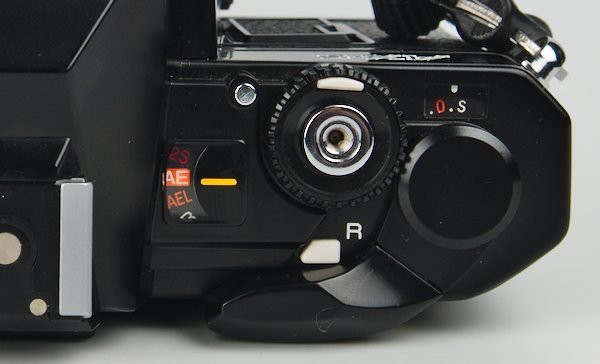
AE - Automatic Exposure
Full auto - Aperture must be set to the orange diamond. The safety lock pin must be depressed in order to set it.
Aperture priority - select the aperture you want on the lens. The camera will take care of the shutter speed. Needs to be a EBC X-Fujinon lens.
Shutter priority - set the lens to the orange diamond.
AEL - Automatic Exposure with Memory Lock
Exposure settings will be locked in once the shutter button is depressed halfway. The classic example of this being useful is with backlit subjects.
The camera can be pointed into the shade to lock in a correct exposure for shadows. Then the shot can be recomposed with the backlit subject.
Multiple Exposures with the Fujica AX-5
Multiple exposures are easy to do with the camera.
After a frame is taken, hold down the white “R” film rewind button and cock the shutter again. This can be repeated to take as many exposures for that frame as you would like.
ASA, ISO Settings
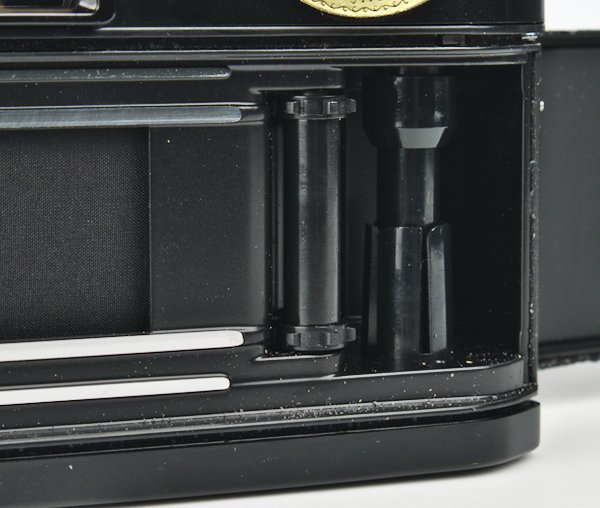
The ASA (ISO) can be set from 12 to 3200 in 1/3 increment stops. That’s a great range and will take some effort to need metering outside of that.
Viewfinder & Focusing Screen
Next to the viewfinder is a switch to close the built-in viewfinder cover. This is an excellent feature to have if you want to do long exposures. It will prevent light leaks from the viewfinder.
The focusing screen uses a split prism surrounded by microprisms. This is my favorite type of focusing screen as I find it the easiest to focus.
Light Metering
The light meter uses silicon photocells. Metering is center-weighted averaging. For tricky lighting or to use flash, a handheld light meter is good to have.
Lens Mount - Fujica X, Fuji AX, F/AX
The lenses use the Fujica X-mount, which is a bayonet-style mount. The naming causes confusion because digital cameras made by Fujifilm use the Fujifilm X-mount.
To get around the confusion, compatible lenses being sold online will often be described as using the Fuji AX mount or F/AX.
Lenses are difficult to find. Most likely you’re going to be limited to 50mm and 55mm Fuji lenses. If you get lucky, you might be able to find a 28mm lens.
An option for third party lenses would be to use Tamron Adaptall lenses. The one catch is that you will need to find a Fujica AX adapter.
The lack of lenses is the biggest downside to the camera. For learning the basics of analog photography, the camera will work well.
Adapting M42 Screw Mount Lenses
Older M42 screw mount lenses can be used on the Fujica AX-5 with an M42 adapter. I do not know how difficult the M42 lens adapters are to find.
35mm Film to Use
You will need to use 35mm film in the camera. If you’re unsure of what film to use, I suggest ISO 400 film unless you will be in direct sunlight.
Black & White 35mm Film
- Ilford HP5 Plus ISO 400
- Kodak T-Max ISO 100 or ISO 400
- Ilford Delta ISO 100
Color 35mm Film
- Kodak Gold ISO 200
- Fujifilm Superia X-TRA ISO 400
- Kodak Porta ISO 400
Camera Accessories
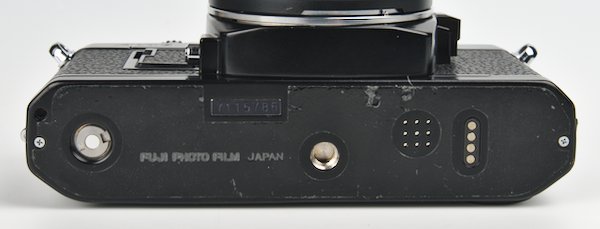
There is a list of accessories in the manual. However, many of them are specialized, like a microscope adapter. This will focus on accessories you might actually want to use.
Fujica Auto Winder X
The auto winder removes the need to manually advance the film. You can see the motor drive coupling and contacts on the bottom of the camera.
4 AA batteries power the auto winder X. It will add a noticeable amount of weight to the camera.
It allows for up to 2 fps shooting. It can also be used on the AX-1 and AX-3.
Auto Strobe Flashes
The two Fujifilm flashes that were available with the initial release of the camera are the Fujica Auto Strobe AZ, and Fujica Auto Strobe 300X.
Mini Camera Review
The Fujica AX-5 has good ergonomics and is solidly built. If you can find one for less than the market value, or already have one, it is a good shooter.
I would not advise going out of your way to buy one. The difficulty in finding lenses is too much of a drawback.
Plus, the camera does not share the mount with a digital camera. With a Nikon F, Pentax PK, Canon EOS, or Minolta A-mount camera, you’ll have more upgrade options in terms of cameras and lenses.
Comparable Cameras
Canon AE-1
The Canon AE-1 is likely the second most popular beginner analog photography camera. It uses Canon FD lenses, of which there are tons of. You won’t be limited to 50mm lenses like with a Fujica.
The only potential downside is that the camera does not have a shutter priority mode. For more information check out my Canon AE-1 Camera Review.
Pentax K1000
What’s the most popular beginner 35mm SLR? The Pentax K1000.
Unlike the electronically controlled AX-5, the K1000 is a mechanical camera. The only thing batteries power are the light meter.
As a result, there is no auto, shutter, or aperture priority modes. You’re going to have to manually control the exposure for every shot you take. Personally, I view that as a good thing. If you’re interested here’s my Pentax K1000 Review.
Canon EOS Rebel G
The Canon EOS Rebel G has all of the shooting modes you would find on a modern DSLR. It takes advantage of the 20 years of technological advancement over the AX-5.
Where it is lacking is in the build quality. The Rebel G was aimed at consumers, and the build quality reflects that. However, because it uses the Canon EOS EF mount, there is a great upgrade path in terms of lenses and cameras.
Fujica AX-5 Manual
A PDF scan of the Fujica AX-5 Manual can be found at Butkus.org.